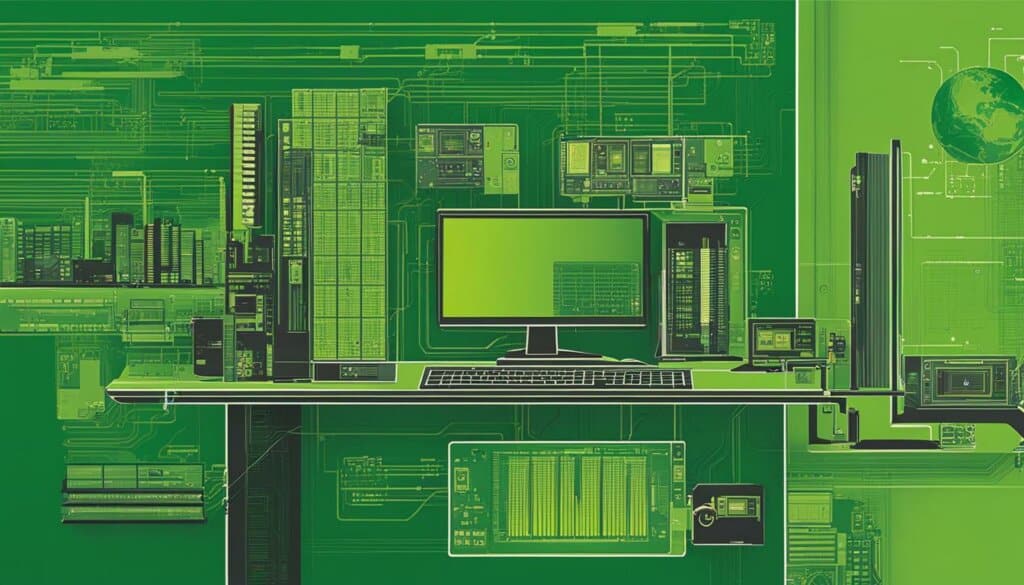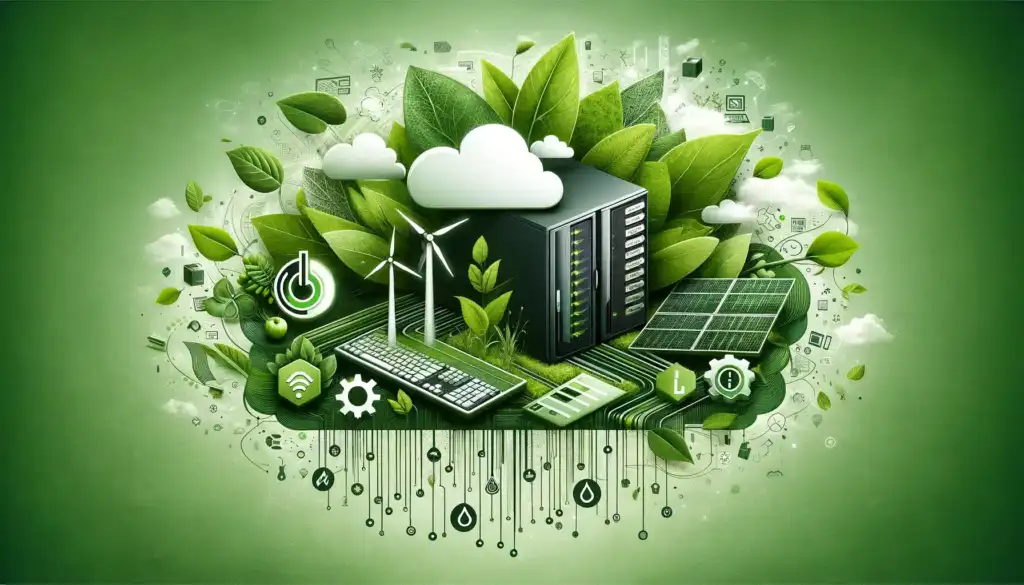Table of Contents
Green technology plays a vital role in computer manufacturing, encompassing sustainable practices, eco-friendly computers, and energy-efficient hardware. With a focus on reducing the carbon footprint and promoting environmentally conscious technology, green initiatives are transforming the landscape of sustainable computer production. By embracing eco-conscious manufacturing, organizations can contribute to a greener future while enjoying the benefits of cost savings, branding gains, and reduced environmental impact.
In this article, we will explore the components of green computing strategies, the importance of adopting sustainable practices, and the challenges organizations may face in implementing eco-conscious manufacturing. We will also delve into the history of green computing, the impact of existing technologies on the environment, and strategies for achieving green computing goals.
What is Green Computing?
Green computing, also known as green technology, is the practice of using computers and other computing devices in energy-efficient and environmentally friendly ways. It involves deploying energy-efficient CPUs, servers, peripherals, and power systems, as well as focusing on reducing resource use and properly disposing of electronic waste. Green computing is an essential part of environmental, social, and governance initiatives that promote sustainable and ethical business practices. By adopting green computing strategies, organizations can reduce their carbon footprint and contribute to the broader goal of environmental sustainability.
Energy Efficiency and Eco-Friendly Practices
Green computing emphasizes the importance of energy efficiency and eco-friendly practices in computer manufacturing. It encourages the use of energy-efficient hardware and components that consume less power while maintaining optimal performance. This includes choosing processors and servers with low power consumption, utilizing power management features to optimize energy usage, and using energy-efficient displays and peripherals.
Additionally, green computing promotes sustainable practices throughout the entire lifecycle of computing devices. This includes proper disposal and recycling of electronic waste, minimizing the use of harmful materials in manufacturing, and considering the environmental impact when designing and producing computer equipment.
The Role of Green Computing in Ethical Business Practices
Green computing is not only about reducing energy consumption and environmental impact; it also aligns with ethical business practices. By adopting green computing strategies, organizations demonstrate their commitment to sustainability, social responsibility, and environmental stewardship. This, in turn, can enhance their reputation and brand image, attracting environmentally conscious customers and stakeholders.
Furthermore, green computing contributes to regulatory compliance and adherence to environmental standards. Many countries and organizations have implemented regulations and guidelines to promote energy efficiency and reduce electronic waste. By embracing green computing, organizations can ensure compliance with these regulations and avoid potential penalties.
Summary
Green computing is the practice of using energy-efficient and eco-friendly technologies in computer manufacturing. It emphasizes the importance of energy efficiency, proper waste disposal, and ethical business practices. By adopting green computing strategies, organizations can reduce their carbon footprint, enhance their brand image, and contribute to the broader goal of environmental sustainability. Implementing energy-efficient hardware, managing power consumption, and considering the environmental impact at every stage of the lifecycle are key elements of green computing.
Green Technology: Components of a Green Computing Strategy
A green computing strategy encompasses various components that help improve energy efficiency and minimize the environmental impact of computer manufacturing. By implementing these components, organizations can adopt sustainable practices and contribute to a greener future. The key components of a green computing strategy include:
- Energy Efficiency: This involves selecting energy-efficient IT equipment, such as computers, servers, and displays, that consume less power during operation. By utilizing energy-efficient hardware, organizations can significantly reduce their energy consumption and carbon footprint.
- Data Centers: Data centers are a significant source of energy consumption in the IT industry. Implementing energy-efficient measures in data centers, such as virtualization, airflow optimization, and advanced cooling techniques, can lead to substantial energy savings.
- Power Management: Organizations can implement power management strategies to control and reduce energy usage. This includes powering down IT equipment when not in use, scheduling automated shut-downs, and enabling sleep or hibernation modes.
- Temperature Optimization: By optimizing temperature settings for cooling systems in data centers and office spaces, organizations can reduce energy consumption while maintaining optimal working conditions for IT equipment.
- Electronic Waste Disposal: Proper disposal of electronic waste is an essential aspect of a green computing strategy. Recycling and responsible disposal of outdated or damaged IT equipment help prevent environmental pollution.
- Alternative Energy Sources: Embracing renewable energy sources, such as solar or wind power, can significantly reduce the carbon footprint of IT operations. Organizations can install solar panels or purchase renewable energy credits to power their computing infrastructure.
- Remote Work: Promoting remote work arrangements and virtual meetings can lead to reduced travel and office space requirements. This not only helps reduce energy consumption but also contributes to a more sustainable work culture.
By incorporating these components into their green computing strategy, organizations can achieve significant energy savings, reduce their environmental impact, and demonstrate their commitment to sustainability. It is crucial for businesses to prioritize and implement these practices to contribute to a greener future.
| Components of a Green Computing Strategy | Description |
|---|---|
| Energy Efficiency | Selecting energy-efficient IT equipment to minimize power consumption. |
| Data Centers | Implementing energy-efficient measures in data centers to reduce energy consumption. |
| Power Management | Enabling power-saving features and automating shut-downs of IT equipment. |
| Temperature Optimization | Optimizing temperature settings in data centers and office spaces to reduce energy usage. |
| Electronic Waste Disposal | Proper disposal and recycling of electronic waste to prevent environmental pollution. |
| Alternative Energy Sources | Embracing renewable energy sources like solar or wind power to reduce carbon footprint. |
| Remote Work | Promoting remote work arrangements to reduce travel and office space requirements. |
Green Technology: Benefits of Green Computing
Implementing green computing practices in computer manufacturing offers numerous benefits for organizations. By prioritizing energy efficiency and adopting sustainable technologies, companies can reap the following advantages:
- Cost Savings: Green computing helps organizations reduce energy consumption, resulting in lower utility bills and operational costs. By utilizing energy-efficient hardware and implementing power management strategies, companies can achieve significant cost savings over time.
- Branding Gains: Embracing green computing demonstrates a company’s commitment to environmental responsibility. This commitment can enhance the organization’s brand image, attracting environmentally conscious consumers and business partners. It can also differentiate the company from competitors and provide a marketing edge.
- Environmental Impact: Green computing reduces the environmental impact of IT assets and operations. By minimizing energy consumption and carbon emissions, organizations contribute to global efforts to combat climate change and promote environmental sustainability.
- Regulatory Compliance: Green computing practices often align with energy conservation regulations and environmental standards. By adopting these practices, organizations ensure compliance with regulatory requirements, reducing the risk of penalties or legal issues.
Overall, green computing offers tangible benefits for organizations, ranging from cost savings to environmental stewardship. By integrating energy-efficient strategies into their operations, companies can position themselves as leaders in sustainability and contribute to a greener future.
Additional Strategies
In addition to the aforementioned benefits, there are further strategies that organizations can implement to optimize their green computing efforts:
- Investing in renewable energy sources, such as solar or wind power, to power IT infrastructure and reduce reliance on fossil fuels;
- Developing policies and training programs to promote energy-conscious behavior among employees, encouraging them to power down devices when not in use and utilize sleep mode;
- Exploring partnerships with e-waste recycling companies to ensure proper disposal of obsolete or damaged IT equipment;
- Collaborating with suppliers and manufacturers to prioritize sustainable practices across the supply chain, including responsible sourcing of materials and recycling initiatives.
By adopting these additional strategies, organizations can maximize the benefits of green computing and make a substantial positive impact on the environment.
Green Technology: Importance of Green Computing
Green computing plays a crucial role in addressing environmental concerns and promoting sustainability in computer manufacturing. Its importance lies in its ability to reduce energy consumption, achieve cost savings, minimize the carbon footprint, ensure regulatory compliance, and provide organizations with a marketing edge.
One of the key benefits of green computing is its positive impact on energy consumption. By implementing energy-efficient strategies and technologies, organizations can significantly reduce their energy usage, leading to cost savings in the long run. This not only helps organizations improve their bottom line but also contributes to global efforts in mitigating climate change by reducing greenhouse gas emissions.
Furthermore, embracing green computing practices allows organizations to minimize their carbon footprint. By adopting energy-efficient hardware, optimizing power management, and exploring alternative energy sources, organizations can reduce their environmental impact. This demonstrates their commitment to sustainability and resonates with environmentally-conscious consumers, giving them a competitive edge in the market.
| Benefits of Green Computing | Description |
|---|---|
| Cost savings | Reduces energy consumption and IT costs |
| Environmental impact | Minimizes carbon footprint and reduces greenhouse gas emissions |
| Regulatory compliance | Helps organizations meet energy conservation regulations |
| Marketing edge | Demonstrates commitment to environmental responsibility, appealing to eco-conscious consumers |
“Green computing is not just a moral obligation; it is a strategic imperative for businesses to thrive in a world where sustainability is of paramount importance.”
In addition to the environmental and cost-saving benefits, green computing also helps organizations achieve regulatory compliance. Many countries have implemented energy conservation regulations, and organizations that adopt green computing practices can ensure compliance with these requirements. This not only helps organizations avoid legal consequences but also demonstrates their commitment to ethical and responsible business practices.
Lastly, green computing provides organizations with a marketing edge. As consumers become more environmentally conscious, they are increasingly inclined to support businesses that prioritize sustainability. By showcasing their green computing initiatives and commitment to environmental responsibility, organizations can attract environmentally-conscious customers and gain a competitive advantage in the market.
Overall, the importance of green computing cannot be overstated. It allows organizations to reduce energy consumption, achieve cost savings, minimize their carbon footprint, ensure regulatory compliance, and differentiate themselves in the market. By embracing green computing practices, organizations can contribute to a more sustainable future and make a positive impact on the environment.

Challenges of Green Computing
Implementing green computing initiatives can pose several challenges for organizations. These challenges include the cost of replacing existing technology assets with energy-efficient devices, upgrades to leased spaces to meet energy-efficiency standards, the lack of expertise in green computing, the initial cost of implementing new green technologies and programs, potential resistance to change within the organizational culture, and conflicting initiatives that may have both positive and negative environmental impacts. Overcoming these challenges requires careful planning, collaboration, and a long-term commitment to sustainability.
The first challenge organizations face is the cost of replacing existing technology assets with energy-efficient devices. While these devices can lead to long-term cost savings, the upfront investment can be significant. Additionally, upgrades to leased spaces may be necessary to meet energy-efficiency standards, which can also incur additional costs.
Another challenge is the lack of expertise in green computing. Many organizations may not have the in-house knowledge or resources to implement and maintain green computing strategies. This can lead to a barrier in adopting sustainable practices and maximizing the potential benefits of green computing.
Quote: “The initial cost of implementing new green technologies and programs can be a deterrent for organizations. However, it is important to recognize that these investments can lead to long-term cost savings and environmental benefits.”
Cultural pushback is another challenge organizations may encounter. Resistance to change within the organizational culture can make it difficult to gain buy-in and support for green computing initiatives. Overcoming this challenge requires effective communication and education to help employees understand the importance and benefits of sustainable practices.
Conflicting initiatives can also pose challenges. Organizations may have multiple sustainability goals and initiatives that may have overlapping or conflicting strategies. It is important to align these initiatives and ensure they are working towards a common goal of reducing environmental impact.
Table: Challenges of Green Computing
| Challenges | Description |
|---|---|
| Cost of replacing existing technology assets | The upfront cost of replacing outdated technology with energy-efficient devices can be significant. |
| Upgrades to leased spaces | Meeting energy-efficiency standards may require upgrades to leased spaces, resulting in additional costs. |
| Lack of expertise in green computing | Organizations may struggle to find or develop the necessary knowledge and skills to implement and maintain green computing strategies. |
| Cost of implementing new green technologies and programs | The initial cost of implementing new green technologies and programs can be a challenge for organizations, but the long-term benefits should be considered. |
| Cultural pushback | Resistance to change within the organizational culture can hinder the adoption of green computing practices. Effective communication and education are key to addressing this challenge. |
| Conflicting initiatives | Organizations may have multiple sustainability initiatives that may have overlapping or conflicting strategies. It is important to align these initiatives and ensure they are working towards a common goal. |
Strategies for Achieving Green Computing
Implementing green computing requires a comprehensive strategy that encompasses various aspects of energy efficiency and sustainable practices. By adopting the following strategies, organizations can make significant progress towards achieving green computing and reducing their environmental impact.
Energy-Efficient Building Environment Systems
One key strategy is to install energy-efficient building environment systems. These systems utilize advanced technologies, such as smart sensors and automation, to optimize energy consumption in buildings. By controlling heating, ventilation, and air conditioning (HVAC) systems, lighting, and other environmental factors, organizations can minimize energy waste and create a more sustainable workplace.
Energy-Efficient Lighting
Another important strategy is to use energy-efficient lighting throughout the organization. By replacing traditional incandescent bulbs with energy-efficient LED lights, organizations can significantly reduce their energy consumption. Additionally, implementing automated lighting controls, such as timers or motion detectors, can further optimize energy usage by ensuring lights are only on when needed.
Energy-Efficient IT Equipment
Investing in energy-efficient IT equipment is crucial for achieving green computing. Organizations should prioritize selecting computers, servers, and other devices that are certified for energy efficiency, such as those with Energy Star ratings. These devices are designed to consume less power and operate more efficiently, reducing the overall energy demand of the organization.
Green Design, Manufacturing, Use, and Disposal
Implementing green design and manufacturing practices, such as using recyclable materials and minimizing waste during production, is essential for achieving sustainable computer manufacturing. Organizations should also focus on promoting green use, which involves encouraging employees to adopt energy-saving habits such as turning off devices when not in use or utilizing power-saving settings. Proper disposal of electronic waste through recycling programs is another crucial aspect of a comprehensive green computing strategy.
| Strategy | Description | |
|---|---|---|
| Energy-Efficient Building Environment Systems | Install advanced systems to optimize energy use in buildings | |
| Energy-Efficient Lighting | Replace traditional bulbs with energy-efficient LED lights | |
| Energy-Efficient IT Equipment | Invest in energy-efficient computers, servers, and devices | |
| Green Design, Manufacturing, Use, and Disposal | Implement sustainable practices in design, manufacturing, use, and disposal |
By implementing these strategies, organizations can significantly reduce their energy consumption, minimize waste, and promote sustainability in computer manufacturing.

A Brief History of Green Computing
Green computing has a rich history that can be traced back to the introduction of the Energy Star program in 1992 by the U.S. Environmental Protection Agency. The Energy Star program aimed to promote energy efficiency in computing hardware and other products. It set standards and guidelines for energy consumption, helping manufacturers develop more environmentally friendly technologies.
Since then, green computing initiatives have focused on improving energy efficiency, reducing the environmental impact of IT operations, and promoting the use of sustainable technologies. The adoption of green computing practices has become more widespread as organizations recognize the importance of environmental sustainability and the benefits of energy-efficient computing.

Today, green computing encompasses a wide range of strategies and practices, including the use of energy-efficient hardware, virtualization, cloud computing, and responsible disposal of electronic waste. It also involves considering the entire lifecycle of IT equipment, from production to end-of-life recycling.
The Energy Star Program – Green Technology
“The Energy Star program has been instrumental in driving energy efficiency in computer manufacturing and promoting sustainable technologies. It has set the foundation for the green computing movement and continues to be a driving force in reducing energy consumption and the environmental impact of IT operations.”
By adopting green computing practices, organizations can not only reduce their energy consumption and lower their carbon footprint but also save on energy costs. Green computing also offers benefits such as improved brand reputation and a competitive edge in the market. As technology continues to evolve, the importance of green computing will only increase, as organizations strive to create a more sustainable future in computer manufacturing and beyond.
| Year | Milestone |
|---|---|
| 1992 | Introduction of the Energy Star program |
| 2001 | Launch of the Electronic Product Environmental Assessment Tool (EPEAT) |
| 2007 | Green Grid, an industry consortium, is formed to promote energy efficiency in data centers |
| 2008 | The European Union introduces the Waste Electrical and Electronic Equipment (WEEE) Directive |
| 2015 | Paris Agreement is signed, committing countries to reduce greenhouse gas emissions |
The Impact of Existing Technologies on the Environment
As technology continues to evolve, it is important to consider the environmental impact of the existing technologies used in computer manufacturing. From data center systems to networking equipment, data storage devices, end-user devices, chips, software, artificial intelligence, and even cryptocurrency, each component has its own set of environmental implications.
Data center systems, for example, consume significant amounts of energy and contribute to greenhouse gas emissions. These facilities often require massive amounts of electricity to power and cool the servers that store and process data. The carbon footprint of data centers has become a growing concern, leading to efforts to improve their energy efficiency and explore alternative cooling solutions.
End-user devices such as laptops, desktops, and mobile phones also have an impact on the environment. These devices consume energy during their operation, and their manufacture involves the extraction of raw materials. Additionally, the disposal of electronic waste from outdated or broken devices poses a significant environmental challenge.
“Technology is both a solution and a challenge when it comes to the environment. While it has the potential to enable sustainable solutions, it also contributes to environmental issues. It is important to find a balance and adopt technologies that promote environmental stewardship while minimizing negative impacts.”
The Role of Artificial Intelligence (AI) and Cryptocurrency
Artificial intelligence has gained prominence in recent years and has the potential to revolutionize various industries. However, the increased computational power required to support AI algorithms and training models has resulted in higher energy consumption. As AI becomes more prevalent, it is essential to develop energy-efficient AI systems and algorithms to minimize its environmental impact.
Cryptocurrency, such as Bitcoin, has garnered attention for its potential to disrupt traditional financial systems. However, the mining process for cryptocurrencies requires substantial computational power and consumes a significant amount of electricity. The energy-intensive nature of cryptocurrency mining has raised concerns about its environmental impact, particularly in regions where the energy used is derived from non-renewable sources.
Summary
The existing technologies used in computer manufacturing have varying impacts on the environment. From data centers to end-user devices, each component contributes to energy consumption, carbon emissions, and electronic waste. It is essential for organizations and individuals to understand these impacts and work towards adopting technologies that promote environmental stewardship and sustainability. Energy-efficient practices, proper disposal of electronic waste, and the development of sustainable alternatives are key to mitigating the negative effects of technology on the environment.
Conclusion – Green Technology
Green computing plays a vital role in computer manufacturing and the pursuit of environmental sustainability. By implementing energy-efficient strategies, organizations can achieve significant reductions in energy consumption, lower their carbon footprint, and contribute to a more sustainable future. The benefits of green computing are numerous, including cost savings, branding opportunities, and a reduced environmental impact.
Despite the challenges that come with adopting green computing practices, its importance cannot be overstated. It is crucial for organizations to prioritize energy efficiency and carbon footprint reduction in order to minimize their impact on the environment. Green computing is not only beneficial for computer manufacturing but also extends to various aspects of our lives.
By embracing green computing, organizations can make a meaningful contribution to environmental sustainability. As the world becomes increasingly aware of the need for energy efficiency and responsible manufacturing, the adoption of green computing practices becomes even more critical. Let us all strive towards a greener future by making conscious choices in computer manufacturing and beyond.
FAQ – Green Technology
What is green computing?
Green computing, also known as green technology, is the practice of using computers and other computing devices in energy-efficient and environmentally friendly ways. It involves deploying energy-efficient CPUs, servers, peripherals, and power systems, as well as focusing on reducing resource use and properly disposing of electronic waste.
What are the components of a green computing strategy?
A green computing strategy includes various components such as deploying smart technology with sensors and AI monitoring tools, powering down IT equipment when not in use, strategic scheduling of computer use, selecting energy-efficient computers and displays, utilizing automated power management features, optimizing temperature settings for cooling, proper disposal of electronic waste, exploring alternative energy and cooling opportunities, and supporting remote work.
What are the benefits of green computing?
Green computing offers benefits such as cost savings, branding gains, and a reduced environmental impact. It allows for cost savings by reducing energy consumption and IT costs. It also helps organizations comply with energy conservation regulations and achieve regulatory compliance. Additionally, it reduces the environmental impact of IT assets, including the carbon footprint, which is beneficial for the overall goal of environmental sustainability.
Why is green computing important?
The key importance of green computing lies in its ability to reduce energy consumption and cost savings for organizations. By implementing energy-efficient strategies and technologies, organizations can significantly reduce their energy consumption and lower their operating costs. Green computing also helps to reduce the carbon footprint of IT assets, contributing to environmental sustainability efforts. Additionally, it helps organizations achieve regulatory compliance and provides a marketing edge by showcasing their commitment to environmental responsibility.
What are the challenges of green computing?
Implementing green computing initiatives can pose several challenges for organizations, including the cost of replacing existing technology assets with energy-efficient devices, upgrades to leased spaces to meet energy-efficiency standards, the lack of expertise in green computing, the initial cost of implementing new green technologies and programs, potential resistance to change within the organizational culture, and conflicting initiatives that may have both positive and negative environmental impacts.
What strategies can organizations implement to achieve green computing?
Organizations can implement strategies such as installing energy-efficient building environment systems, using energy-efficient lighting with timers or motion detectors, purchasing energy-efficient IT equipment, adopting green design and manufacturing practices, minimizing energy consumption during the use of IT equipment, and properly disposing of or recycling electronic waste. By implementing these strategies, organizations can reduce their energy consumption, minimize waste, and promote sustainability in computer manufacturing.
What is the history of green computing?
Green computing has a history that dates back to the introduction of the Energy Star program in 1992 by the U.S. Environmental Protection Agency. This program aimed to promote energy efficiency in computing hardware and other products. Since then, green computing initiatives have focused on improving energy efficiency, reducing the environmental impact of IT operations, and promoting the use of sustainable technologies.
What is the impact of existing technologies on the environment?
Different technologies used in computer manufacturing have varying impacts on the environment. For example, data centers consume significant amounts of energy and contribute to greenhouse gas emissions. End-user devices and chips consume energy during operation. Software can consume energy when transmitting large amounts of data. Understanding the environmental impact of these technologies is crucial for promoting green computing and minimizing their negative effects on the environment.






